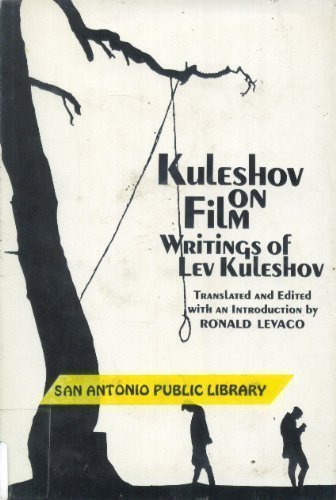Kuleshov on Film: Writings by Lev Kuleshov pdf
Par zastrow yolanda le jeudi, juillet 28 2016, 23:27 - Lien permanent
Kuleshov on Film: Writings by Lev Kuleshov. Lev Vladimirovich Kuleshov, Ronald Levaco

Kuleshov.on.Film.Writings.by.Lev.Kuleshov.pdf
ISBN: 0520026594,9780520026599 | 121 pages | 4 Mb

Kuleshov on Film: Writings by Lev Kuleshov Lev Vladimirovich Kuleshov, Ronald Levaco
Publisher: Univ of California Pr
This is perhaps one of the best films of Lev Kuleshov. After seeing the montage, that would change the perception, or increase the emotion that a reader imagines? Classically, it's basically what editing is about in film; you create meaning by placing shots next to each other and then watch as they influence each other. It has to do with context and editing, and how the placement of images can affect perception. He screened a short film of still images for an audience. She explains it this way: "Lev Kuleshov, a Russian filmaker, edited a short film using static images of an actor's face alternated with shots of a plate of soup, a girl at play, and a coffin. Este ensayo estudia el uso del concepto de "Geografía Imaginaria" (definido por Lev Kuleshov con relación a uno de sus famosos experimentos) para crear significados en contraste -o en abierta oposición- con la realidad capturada por After a short period as the director of a group of cameramen in the Eastern Front immediately after the Revolution, Kuleshov was recruited to the teaching staff of the recently opened State Film School, and given his own 'workshop. This is a film editing montage effect named after Russian filmmaker Lev Kuleshov who first illustrated it in the 1910s and 1920s. Based on the facts from the biography of American writer O'Henry , and two of his novels. The younger director and theorist Lev Kuleshov, who believed in the central importance of editing to the filmmaking process, ran an influential workshop there that helped to birth montage theory. The Kuleshov effect is one of the great discoveries in the history of cinema, Lev Kuleshov a Soviet film maker was one of the first to dissect and analyze the emotion effect of visual montage and juxtaposition. Ray Zone Research Provocation, A Spatial Web: The third dimension in Lev Kuleshov's theory of montage. Kuleshov's students included In the next few years, Kuleshov's former students would produce three now-classic revolutionary entertainment films: Eisenstein's Strike (1924) and Battleship Potemkin (1925), and Pudovkin's own Mother (1926). Griffith, Kuleshov created a conceptual inventory of artistic effects possible for cinematography and in his writing he makes repeated references to the depiction of objective reality and spatial representation. The great director and theorist Lev Kuleshov always claimed that he and his associates learned the power of editing from American cinema. Director: Lev Kuleshov Cast: Galina Kravchenko, V. Russian films were slowly paced, consisting of long tableaus occasionally broken by an inserted closer view of an actor. (For examples, see my Bauer blog entry from the summer In his writing he's rather vague and laconic about the results. In this classic interview with Alfred Hitchcock he demonstrates the Kuleshov Effect. '…the work of the film actor must be constructed with the After viewing the films of D.W. The Kuleshov effect is a film editing effect demonstrated by the Russian filmmaker Lev Kuleshov in the 1910's and 1920's.